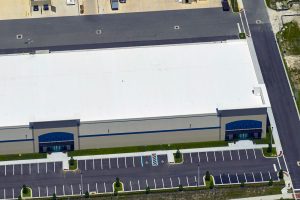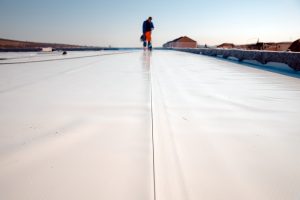
PVC Roof vs TPO: Which Roofing Material is Best for You?
If you’re deliberating between a PVC roof and TPO for your New Orleans property, our comprehensive comparison will assist you in weighing the factors of expense, longevity, energy efficiency, and ease of installation. Explore the nuances of the “PVC roof vs TPO” discussion through this guide to determine which roofing solution aligns best with your building’s needs in the unique climate of New Orleans.
Below is a side-by-side comparison of PVC and TPO roofing systems across key factors:
| Feature | PVC Roofing | TPO Roofing |
|---|---|---|
| Installation | Easier to install due to flexibility; heat-welded seams create a strong bond. | More labor-intensive to install; seams are also heat-welded for water resistance. |
| Energy Efficiency | Highly reflective surface improves energy efficiency. | Excellent reflectivity, particularly effective in warmer climates to reduce cooling costs. |
| Durability | Long lifespan of 20-30 years with proper installation and maintenance. | Good durability with a lifespan of 15-30 years with proper installation and maintenance. |
| Cost | Higher initial cost. | Lower initial cost. |
| Fire Resistance | High fire resistance, often with Class A ratings. | Lower fire resistance compared to PVC, with added chemicals for protection. |
| Chemical Resistance | Superior chemical resistance, ideal for industrial applications. | Moderate chemical resistance, ideal for residential and most commercial applications. |
| Environmental Impact | Recyclable at the end of its lifespan, with several eco-friendly certifications. | Recyclable and meets various environmental standards. |
Now, let’s delve into each of these factors in more detail to provide a comprehensive understanding of PVC and TPO roofing systems for New Orleans property owners.
Understanding PVC and TPO Roofing Systems
In the realm of industrial and commercial roofing, including in New Orleans, PVC (Polyvinyl Chloride) and TPO (Thermoplastic Polyolefin) stand out as popular choices for single-ply membrane systems. Both are especially well-suited to covering flat or low-slope roofs, providing exceptional protection against various weather conditions along with straightforward installation and upkeep processes. While both TPO roofing materials and PVC membranes serve similar applications in commercial roof projects, they exhibit distinct differences in their chemical makeup and physical attributes.
Having been on the market since 1966, PVC is a veteran among roofing materials while TPO emerged more recently in 1991. It was introduced as an alternative that promised lower costs alongside enhanced environmental benefits when compared to traditional PVC material options. Understanding these specific features of each type can greatly assist New Orleans property owners in deciding which system will best meet the needs of their structure’s coverage requirements.
What is PVC Roofing?
PVC roofing comprises:
- A robust sandwich construction featuring two layers of polyvinyl chloride with a central polyester reinforcement scrim.
- To boost longevity and protection against sunlight, which is particularly intense in New Orleans, the uppermost layer is imbued with substances that are resistant to UV radiation.
- It’s known for its pliability—an attribute greatly improved by infusing plasticizers—thus facilitating swift installation as it molds easily to diverse roof designs.
When installing PVC roofing membranes, their seams undergo heat welding which ensures they merge into a sturdy, impermeable bond significantly diminishing leakage risks. Even though over time some plasticizers may degrade, affecting the material’s lifespan, advancements such as KEE (Ketone Ethylene Ester) in PVC enhance both flexibility and endurance thus preserving the membrane’s integrity longer. This makes PVC an excellent option for widespread commercial roofing uses in New Orleans.
What is TPO Roofing?
A TPO roofing system, known for its superior puncture resistance and high reflectivity, is a single-ply membrane that incorporates a polyester mat reinforcement. This type of roofing utilizes membranes made from ethylene or polyethylene thermoplastic combined with ethylene propylene rubber to create its unique properties. The versatile nature of TPO roofs allows for various installation methods such as mechanical attachment, adhesion, or ballasting to suit the specific demands of each roofing project in New Orleans.
When TPO roofs are properly installed and maintained, they have an expected lifespan ranging from 15 to over 30 years. Certain lower-grade products may exhibit early signs of aging like shrinkage or cracking. TPO’s energy-efficient qualities due primarily to its reflective surface make it a wise choice for those looking to cut cooling costs in New Orleans’ warm climate where this can be particularly beneficial.
Key Differences Between PVC and TPO Roofing Materials
When comparing PVC and TPO roofing options for New Orleans buildings, it’s important to consider their distinctive capabilities regarding chemical resistance, fire resistance, and overall durability. These elements are crucial as they greatly influence the efficacy and life span of your roofing system. Deciding on either material should be based on the building’s specific needs.
Chemical Resistance
PVC roofing offers high resistance to a wide array of chemicals, including acids, oils, and grease. This makes it suitable for roofs on commercial and industrial structures in New Orleans where exposure to such substances is frequent. The chemical resistance of PVC membranes stretches to cope with environmental pollutants and various acids, positioning them as particularly apt for edifices that are engaged in chemical handling or situated within areas suffering from pollution contamination. Restaurants in New Orleans find particular advantage in employing PVC for their rooftops due to its robustness against grease and oils, which ensures longevity and resilience over prolonged periods.
TPO roofing provides moderate chemical resistance, which is sufficient for many commercial and residential applications. However, interactions with specific types of chemicals including certain cleaning agents or chemically altered condensates emanating from HVAC systems can potentially affect TPO membranes’ integrity. When superior endurance against harsh chemicals is required for a roof’s performance criteria, PVC may be a more suitable choice compared to TPO options.
Fire Resistance
When selecting a roofing material for a New Orleans property, it’s essential to take into account the element of fire resistance. PVC stands out for its natural ability to resist fires, ranking as a top choice among single-ply roofing membranes in terms of fire resistance. This characteristic brings an extra level of safety and security to structures outfitted with PVC roofs. Some varieties of PVC membranes have even secured Class A ratings – the most distinguished grade available for fire-resistant materials – thereby offering another layer of protection particularly crucial for buildings at greater risk from fires.
TPO membranes incorporate added chemicals that enhance their capacity to withstand flames. While they may not reach the same levels of fire resistant properties as PVC, TPO membranes still offer a good measure of defense against fires. The specific fire resistance needs of your building should be considered when choosing between these materials.
Durability
Both PVC and TPO roofing systems are designed to endure harsh weather conditions such as severe temperatures, potent winds, and hail impacts, which can be particularly relevant in New Orleans’ subtropical climate. PVC roofs typically boast a long lifespan with correct installation and consistent maintenance. In terms of resistance against punctures and tears, some PVC roofing products have shown significant performance.
TPO roofing has also shown considerable performance in regions that frequently encounter extreme weather events, like New Orleans. Because TPO is relatively new on the market compared to PVC roofs, there’s less historical data available regarding its longevity under certain environmental stressors. Both PVC and TPO materials are vulnerable to cracking, chalking or fading when exposed continuously to intense UV radiation and elevated temperatures, which are common in New Orleans. The choice between the two often comes down to specific project requirements and long-term performance expectations.
Installation Methods for PVC and TPO Roofing Systems
The installation techniques for both PVC and TPO roofing systems are crucial to the final functionality and service life of a roof in New Orleans’ unique climate. These materials can be fitted onto roofs using an array of approaches, including:
- Utilizing hot asphalt
- Securing with mechanical fasteners
- Applying cold adhesive
- Performing induction welding
Ease of Installation
PVC roofing is known for its flexibility, which can make it easier to adapt to diverse shapes and dimensions of roofs. This property can expedite the installation work while potentially reducing labor demands. The broad dimensions available for PVC membranes also play a part in minimizing seam requirements, which can contribute to a more streamlined setup.
TPO membranes, while potentially lighter and offering advantages in terms of transport and handling, may require different installation techniques. The specific installation process can vary depending on the manufacturer and product line. Both PVC and TPO can benefit from modern installation technologies like induction welding systems, which can help optimize efficiency during the roofing process.
Custom Fabrication
Some PVC roofing products offer the benefit of custom fabrication, which can reduce the chance of mistakes and potential leaks during on-site installation. This method of manufacturing in a controlled factory setting can provide uniformity and precision to the produced roofing materials. It may also result in a reduction in seams compared to conventional methods, potentially improving overall roof strength and longevity.
While custom fabrication is more commonly associated with PVC roofing, some TPO manufacturers also offer prefabricated options. The choice between custom fabricated and field-fabricated roofing often depends on the specific project requirements and the capabilities of the chosen roofing contractor.
Energy Efficiency of PVC and TPO Roofing Systems
For any commercial roofing system in New Orleans, energy efficiency is of paramount importance due to the city’s hot and humid climate. Both PVC and TPO roofing materials contribute significantly to this aspect. The materials have naturally reflective surfaces which help to reduce UV radiation penetration. This in turn facilitates greater energy efficiency. The Solar Reflectance Index (SRI) measures how hot a roofing surface can become under full sun exposure, with higher values indicating better reflectivity and energy efficiency.
Light-colored TPO or PVC roofing can offer superior solar reflectance compared to darker-colored variants, helping to keep buildings cooler and reduce air conditioning use. Both materials exceed EPA Energy Star requirements for energy efficiency, making them excellent choices for commercial buildings looking to reduce their energy consumption and environmental impact.
Reflectivity
Both PVC and TPO roofing systems are engineered with highly reflective properties, which serve to minimize heat uptake and contribute to energy savings by cutting down on the need for air conditioning. The initial Solar Reflectance Index (SRI) of white PVC and TPO membranes can be notably high, showcasing superior reflectivity. This characteristic is particularly beneficial in New Orleans’ warm climate.
Roofing systems made of PVC and TPO that boast higher SRI values bring multiple advantages:
- Increased energy efficiency results in prolonged service life for A/C units while decreasing expenses associated with cooling
- Mitigation of urban heat island impacts leads not only to improved local air quality but also reduces city-wide power use
- Promotion of better energy efficiency enhances building sustainability
Impact on Cooling Costs
In hot climates like New Orleans, both PVC and TPO roofing offer advantages due to their reflective capabilities that can greatly diminish the need for air conditioning in commercial structures. The benefits associated with these roofing systems are numerous:
- Outstanding reflectivity aids in repelling the sun’s thermal energy from a building, leading to a cooler interior
- Minimization of reliance on artificial cooling methods
- Enhanced energy efficiency
- Strong and resilient over time
Both PVC and TPO roofs are compatible with eco-friendly elements such as green roof layers and photovoltaic panels which promote savings on energy costs. When incorporated into holistic sustainable building strategies, such environmentally conscious choices enable owners of commercial buildings to considerably lower their total expenditure on energy.
Cost Considerations: PVC vs. TPO Roofing Systems
Understanding the financial implications is crucial for any roofing project, as it influences the choice between different roofing systems. Initial installation prices along with ongoing upkeep costs must be weighed when deciding between PVC and TPO roofs. The cost to install either system can vary significantly depending on factors such as the size of the roof, the complexity of the installation, and the specific products used.
When comparing TPO to PVC in terms of affordability, TPO often emerges as more budget-friendly initially—appealing for many commercial structures looking at initial outlays. However, one shouldn’t overlook subsequent expenditures such as maintenance and repair over time. These can substantially influence the total value derived from your chosen roofing solution throughout its lifespan.
Maintenance and Repairs
PVC and TPO roofing systems are known for their low maintenance requirements, typically needing only periodic inspections and light cleaning or small repairs to address minor abrasions. While both types of roofs need little upkeep, the ease and cost of repairs can vary.
When comparing the two materials over the long term, several factors should be considered:
- Expected service life
- Resilience against wear-and-tear
- Cumulative repair expenses over time
- Frequency of necessary repairs throughout its use
It’s important to consider the eventual disposal impact. At the end of their useful lives, both PVC and TPO roofs can be recycled, but the processes and availability of recycling facilities may vary. This can affect both environmental considerations and potential disposal costs.
Sustainability and Environmental Impact
As the focus on environmentally sustainable building practices sharpens in New Orleans, modern roofing has to adapt. PVC and TPO are two types of roofing materials that boast eco-friendly advantages as well as various certifications in support of sustainability.
Recyclability
Both PVC and TPO offer recyclability options, which is an important sustainability feature:
- The recycling process for PVC roofing typically involves gathering the material, pulverizing it, and repurposing it to produce new membrane layers.
- TPO also offers recyclable options, with some manufacturers integrating eco-friendly components into their TPO production processes.
- By cutting down on waste and encouraging the reuse of materials, these recycling methods help curtail the ecological footprint associated with roofing endeavors.
It’s worth noting that the lifespan of the roofing material can impact its overall environmental footprint. Longer-lasting materials may result in less frequent replacements, potentially reducing waste over time.
Eco-Friendly Certifications
Eco-friendly certifications are important indicators of the environmental impact of roofing materials like PVC and TPO. Various manufacturers have received certifications for their roofing products, ensuring that the materials meet rigorous standards for sustainability and environmental performance.
Both PVC and TPO roofing can offer several environmental benefits:
- Lower environmental impact compared to some traditional roofing materials
- Compliance with energy efficiency standards, such as California’s Title 24 Energy Efficiency Building Standards
- Potential for LEED credits in green building projects
- Options for low or no VOC (Volatile Organic Compounds) formulations, making them suitable for sustainable building practices
These certifications and environmental features highlight the contributions of both PVC and TPO to reducing the environmental footprint of commercial buildings in New Orleans.
Choosing the Right Roofing Material for Your Needs
When selecting the right roofing material for your New Orleans property, it is essential to consider several elements such as:
- The geographical position of the building
- Local weather conditions, including heat, humidity, and potential for severe weather
- Intended function of the property (commercial, industrial, or residential)
- Anticipated future developments or changes to the building
- Budget considerations, both short-term and long-term
- Energy efficiency goals
- Environmental and sustainability priorities
It’s vital to consult with a seasoned roofing contractor who can provide expert guidance tailored to your project’s specific needs. This will help ensure that you select an appropriate material for your roof.
Building Location and Climate
Choosing the appropriate roofing system for a property in New Orleans requires careful consideration of several factors including the building’s location, surrounding climate, potential hazards, and adherence to local construction regulations. These considerations are crucial in maximizing energy efficiency and obtaining the intended benefits in terms of cooling and durability.
The robustness and resistance to chemicals that PVC roofing offers can make it an excellent option for environments subjected to industrial pollution or severe climatic events. Meanwhile, TPO’s high reflectivity can be particularly beneficial in New Orleans’ hot climate for reducing cooling costs.
Building Usage and Future Plans
In making a choice between PVC and TPO roofing options, one should take into account the long-term vision for the structure. Consider factors such as:
- The current and future use of the building
- Potential for incorporating environmentally friendly features like green roof systems
- Anticipated maintenance and repair needs
- Possibility of future expansions or modifications to the roof
Both PVC and TPO can be customized to fit the present function of your building and accommodate future changes.
Conclusion
Both PVC and TPO roofing systems present unique benefits tailored to different situations in New Orleans. PVC is distinguished by its chemical resistance, fire resistance, and long-standing track record, while TPO offers excellent reflectivity and energy efficiency at a competitive price point. Your choice between PVC and TPO should be based on your individual requirements, fiscal constraints, and long-term objectives.
By meticulously evaluating the factors discussed in this guide – including installation methods, energy efficiency, cost considerations, durability, and environmental impact – you can reach a well-informed decision that delivers optimal performance and value for your New Orleans roofing project.
Contact M&J Roofing for Your New Orleans Roofing Needs
Now that you have a comprehensive understanding of PVC and TPO roofing systems and how they perform in New Orleans’ unique climate, you may have questions about which option is best for your property. M&J Roofing is here to help. As New Orleans’ trusted roofing experts, we have extensive knowledge of both PVC and TPO roofing systems, with particular expertise in TPO roofing installation.
Our team of experienced professionals is ready to assist you in making the best choice for your roofing needs, taking into account your specific requirements, budget, and long-term goals. We can provide personalized advice and ensure a high-quality installation, whether you choose PVC or TPO for your roofing project.
Don’t let roofing decisions overwhelm you. Contact M&J Roofing today for any roofing questions or to discuss your roofing project. Call us now to get started on your roofing project and experience the M&J Roofing difference!
Frequently Asked Questions
What are the main differences between PVC and TPO roofing materials?
PVC and TPO roofing materials differ in terms of their chemical resistance, fire resistance, and longevity. PVC generally offers higher chemical and fire resistance, while TPO is known for its affordability and high reflectivity. Both materials have their strengths and the choice often depends on specific project requirements.
Which roofing material is more cost-effective?
The cost-effectiveness of PVC and TPO roofing can vary depending on specific project requirements and long-term considerations. While TPO often has lower initial costs, PVC may offer advantages in terms of longevity and durability that could result in lower long-term costs. It’s important to consider both initial installation costs and long-term maintenance and replacement costs when evaluating cost-effectiveness.
How do PVC and TPO roofing materials impact energy efficiency?
Both PVC and TPO roofing materials can enhance energy efficiency due to their highly reflective nature, which diminishes heat absorption and can lower expenses associated with cooling. This characteristic is particularly advantageous in warm climates like New Orleans. The specific energy efficiency benefits can vary based on the color and formulation of the roofing material.
Are PVC and TPO roofing materials environmentally friendly?
Both PVC and TPO roofing materials offer environmental benefits. They are both recyclable at the end of their lifespan and can contribute to energy efficiency. PVC has a long history of recycling programs, while TPO is designed with environmental considerations in mind. Both materials can help buildings meet various environmental and energy efficiency standards.
What factors should I consider when choosing between PVC and TPO roofing?
When selecting between PVC and TPO roofing, it’s essential to evaluate factors such as the building’s location, local climate conditions, intended use of the building, budget considerations, energy efficiency goals, and long-term objectives. Other factors to consider include chemical exposure, fire resistance requirements, and anticipated maintenance needs. Consulting with a professional roofing contractor can help in making the best decision for your specific situation.




